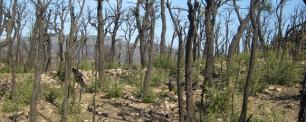Forest wildfires: learning from the beast
We are in the middle of the wildfire season, and the ecologist Francisco Lloret explains what we can learn about fires and how we can adapt to them to avoid catastrophic large wildfires.
![]()
To Jaume.
Last April we learned about the death of Dr Louis Trabaud. He was a magnificent ecologist who dedicated his professional life in Montpellier to the study of forest fires in the Mediterranean. He had visited California where he established links with a group of great scientists working on vegetation wildfires. Californian ecologists had developed a concept that Louis Trabaud successfully applied into the Mediterranean basin, collaborating generously with many researchers here. The concept is based on recognizing the ability of Mediterranean ecosystems to recover quickly after a fire, effectively rebuilding their composition of species and their shrub or forest cover. This process was quite successfully called “autosuccession” by T.L. Hanes in 1971, although it has received other names, such as 'self-replacement', in forestry or in other regions.
The autosucession is based on the ability of many Mediterranean species to regrow new stems or to establish new generations from seeds that germinate abundantly after fire. This idea arises from field observation, and has multiple implications, from the knowledge of plant physiology to the management of burned areas. In Eastern Spain, it has been used with remarkable success in the restoration of burned areas. The idea also allows to explain the dynamics of Mediterranean ecosystems. On the one hand, it provides a clear example in which to apply the concept of ecological resilience —the ability of an ecological system to recover its properties after being disturbed. In addition, it recognizes fire as a component of its functioning, as in many other ecosystems. It also has evolutionary implications, addressing the role of fire in the evolution of Mediterranean species.
The concept is based on recognizing the ability of Mediterranean ecosystems to recover quickly after a fire, effectively rebuilding their composition of species and their shrub or forest cover. This process was quite successfully called 'autosuccession'.
The idea had a remarkable success among the ecologists of the Mediterranean basin. In those years the predominant thinking considered fires as a degradation process of ecosystems, mainly due to the human pressure, similar to overgrazing. This degradation would imply simplification and trivialization of plant communities —that is, a regression in succession— and a serious risk of soil loss. The autosuccession concept provided sound mechanisms —resprouting, germination— to be tested through experimentation and systematic observation. The approach also allowed the recognition of fire as an element of Mediterranean ecosystems and introduced the novel idea that Mediterranean vegetation was adapted to fire. Ecologists worked hard to transmit this strange idea in the media and to transfer it into forest management. The beast —the fire— was not bad in itself, indeed we should learn to coexist with it, while minimizing its most terrible strikes. We are still immersed in the learning of this coexistence.
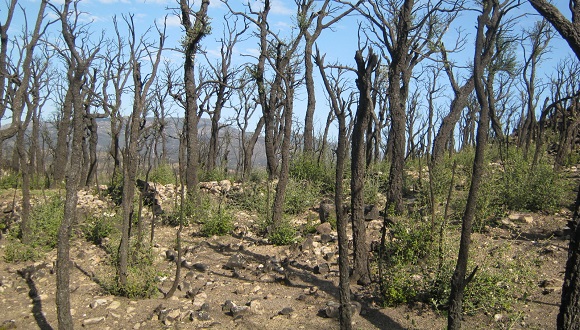
One of the main conclusions of the avalanche of studies arising from the autosuccessional perspective is that the resilience of Mediterranean vegetation to fire has a limit. It depends on the intensity of the fire —logically a fire that passes by quickly scorching the vegetation will cause less damage than a fire in which very high temperatures are reached— but also on the sequence of fires over time. If the fires occur with little interval between them their impact will be greater, since the capacity to accumulate reserves of new seeds, or carbohydrates that rebuild new organs will be seriously compromised.
The concept of fire regime describes the complexity of fires occurring in the territory with different intensity, frequency and extent. It is a concrete case of disturbance regime, a concept developed by ecologists to describe the dynamics of ecosystems in general. Incorporating the fire regime into our vision of Mediterranean ecosystems also allowed the comparison with other regions of the world where wildfire is a fundamental element of their ecology. This is the case of boreal forests, and particularly of savannas, the largest contributors to CO2 emissions into the atmosphere caused by fires. But also of many temperate forests in which surface fires are very frequent, primarily affecting litter and understory. Therefore, we must be aware that Mediterranean ecosystems have not the exclusive of fires in the world.
The beast —the fire— was not bad in itself, indeed we should learn to coexist with it, while minimizing its most terrible strikes. We are still immersed in the learning of this coexistence.
The temporal perspective of fire regime combined with a mechanistic view of the phenomenon has very important implications in fire management. The mechanistic view teaches us that fire is simply a chemical oxidation reaction that releases a great amount of energy. But the reaction needs a certain amount of activation energy. The energy released in the combustion of something that is burning —for instance, a simple match— serves to activate the fire in a nearby fuel. In this way, the fire spreads. Therefore, in order to have a fire, three things are needed: fuel, a source of heat and oxygen. Sometimes we forget oxygen, but it is critical to understand why a thin branch burns better than a thick, compact trunk. The greater contact surface offered by the twig to the oxygen of the air greatly facilitates its combustion. On the contrary, a log actually only burns on its outer surface. This explains the great flammability of Mediterranean vegetation, in which a large number of fine branches accumulate. In addition, the fine branches get dried fast, also because they offer more contact surface to the atmosphere, particularly in the dry Mediterranean summer. The amount of water in the fuel dampens fire because the energy released by the combustion is used to evaporate the water, leaving less energy to continue activating the burning chemical reaction. That is why we use water to extinguish fires. Finally, the Mediterranean vegetation is rich in volatile substances that ignite very easily in the air, and with the consequent release of energy they propagate the fire to the near fuel.
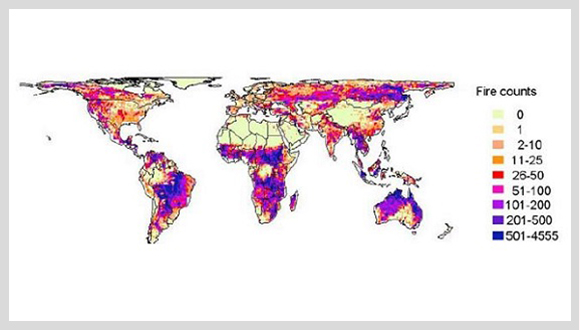
Some forest ecologists postulate that fire is the great modeler of forest dynamics in the long run.
Fuel is a particularly important component of forest fires since it allows to connect with the temporal dimension of the phenomenon. Vegetation does not stop photosynthetic assimilation as long as radiation, water and nutrients are available. In the absence of agents reducing biomass —such as humans or their domesticated herbivores—, fuel is inexorably accumulating. Indeed, some forest ecologists postulate that fire is the great modeler of forest dynamics in the long run. And the more fuel forests accumulate, the more energy will be released with fire. This explains why the herbaceous dry vegetation of the savannas burns very often —every two or three years on average— with low intensity fires. And this also explains the extreme virulence of some fires of the Mediterranean regions with large fuel loads. But in turn, fire acts as a vaccine against burning immediately afterwards, at least with great intensity, as it reduces fuel. It follows that if we extinguish all fires with absolute efficiency without reducing fuel by other ways, we are favoring future fires of great intensity —and probably extension.
It is what we could call the 'paradox of extinction'. This deduction, supported by different simulation models and some empirical observations, has led in some regions to implement controlled fires practices —also called prescribed fires— under low intensity conditions, such as those occurring in the winter season. But these practices have also problems. On the one hand, there is the difficulty of being accepted by a society —largely urban— that has been educated in the paradigm that fire is a beast and we must not play with it. On the other hand, for fuel reduction to be effective it should be repeated before fuel is re-accumulated. This, in addition to being expensive, raises the problem to avoid the system to be moved to the limit of its recovery capacity, that is, its resilience. Finally, there is the difficulty of implementing these practices to cover a significant portion of the territory, sufficient to prevent the spread of large fires. These practices have a significant economic cost, as the active extinction of the fires also has. In fact, management and extinction of fires consume the vast majority of the public economic resources destined to the forest world.
These practices have a significant economic cost, as the active extinction of the fires also has. In fact, management and extinction of fires consume the vast majority of the public economic resources destined to the forest world.
Fire management is an extremely complex issue, largely because it must deal with the uncertainty of future catastrophes. However, there are some priorities that, while obvious, need to be highlighted. In the first place, the safety of the people and their housing and properties must be preserved. In the face of a burning fire, this must be the top priority. This is what we must absolutely support the heavy task of firefighters. Second, extinction is not enough to manage forest fires. It is often said that fires are fought in winter, suggesting that it is the time to reduce fuel, and to prepare the logistics of extinction. But such specific actions in just one season of a year are not sufficient to counteract the social trends of decades that have caused a displacement of the rural population to the cities. This migration corresponds to an abandonment of agricultural, grazing and forestry activities that involved a reduction of fuel in the past. It has sometimes been proposed to reverse this trend by subsiding practices that reduce fuel load. But the economic cost is too great in front of other priorities of the society; so, this line of action has not generally been successful. It has also been considered the exploitation of fuel as a means to obtain economic revenues. The use of domesticated herbivores is along this line, and more recently it has been proposed to generate energy from fuel biomass. But these options raise doubts about its economic viability, in addition to the need of a precise analysis of their impact on forests.
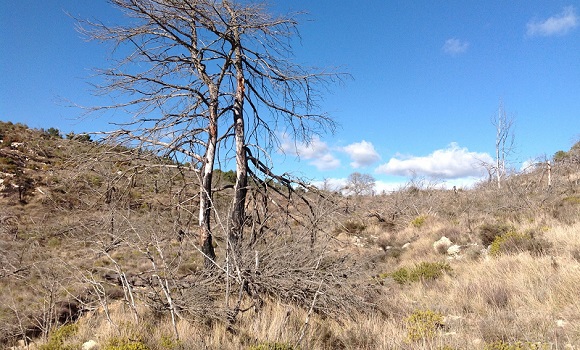
Management involves setting priorities for action by applying cost-benefit analyses. This is most evident when resources are scarce. In the case of fuel, management involves identifying areas where their reduction would minimize the risk of spreading high-intensity wildfires to inhabited areas and to sensitive natural systems. This strategy has the undeclared advantage of accepting that some areas will burn and thus their fuel will be reduced. We have a whole arsenal of methodological tools (geographic information systems, wildfire propagation models, etc.) that can help to this end.
Extinction is not enough to manage forest fires. It is often said that fires are fought in winter, suggesting that it is the time to reduce fuel, and to prepare the logistics of extinction.
In addition to the accumulation of fuel associated with changes in land use and social patterns, we must add the evolution of the climate. Climate change is a reality that involves an increase in temperatures, and therefore brings us closer to the ignition threshold of the fuel. In addition, in the Mediterranean region we see that this increase in temperatures is not offset by more abundant rainfall, but rather the opposite. The worst weather combination for fires occurs on days with high temperature and low relative humidity. If there is also wind, the spread of fire is faster.
It has been statistically verified that the number of days of the year with extreme fire risk conditions has increased since the second half of last century. In addition, if very high temperatures are reached, the behavior of the fire becomes explosive, with an enormous release of energy involving the simultaneous combustion of large amounts of biomass. In days of extreme fire risk, firefighters are overwhelmed by the number and virulence of wildfires. And those climatic conditions are going to become more frequent in the future. There are projections that venture the future fire regime —in the next century— in the Mediterranean Basin. These simulations show that weather conditions will become generally more conducive to fires. The areas in which climatic fire risk will increase more will be those that historically have experiences less fires —like mountain— because they have experienced lower temperatures and more precipitation.
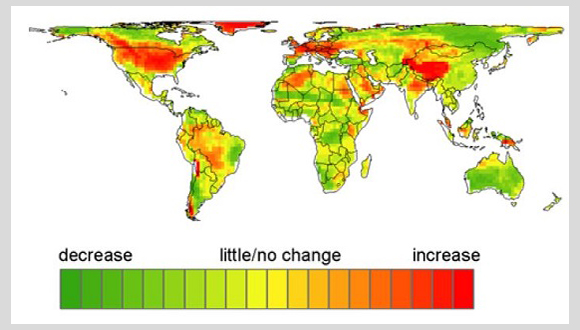
But interestingly, these projections also indicate that fires will overall decrease in the Mediterranean region, despite the increasing climatic fire risk. The explanation is that there will be less fuel available to burn, simply because weather conditions will not be favorable to vegetation growth. This is currently observed in semiarid regions where fires are rare because of small fuel load. The question is whether the vegetation will dry first and then it will burn, or it will burn first and then it will not be able to reestablish itself. The fires could thus constitute the great catalyst of a transformation towards a more arid landscape, with little vegetation cover.
The number of days of the year with extreme fire risk conditions has increased since the second half of last century. In addition, if very high temperatures are reached, the behavior of the fire becomes explosive, with an enormous release of energy involving the simultaneous combustion of large amounts of biomass.
How can we act under this scenario? In addition to highlighting all actions aimed at reducing greenhouse gas emissions, we can apply what we have learned from fire behavior and vegetation resilience. First, minimizing as far as possible fires of great intensity and extent that could limit vegetation resilience, in addition to threaten human populations. The preservation of the vegetal cover plays a key role avoiding soil loss and facilitating plant growth and reconstruction of trophic networks. However, wildfires are a component of the dynamics of ecosystems and its complete eradication is impractical and counterproductive. Therefore, we need a strategy identifying sensitive areas and developing management practices that involve less vulnerability in terms of exposure to fire risk and sensitivity to its effects.
This implies an integrated management, which means setting priorities under the principles that (1) what happens at a point in the territory affects other areas and (2) in each area the balance cost-benefit of our actions is different. There will be more fires in the future, and unfortunately some of them will be catastrophic. Our goal should be to preserve as much as possible the ecosystem's capacity to recover, minimizing high recurrences and intensities. We envisage a future, heterogeneous landscape in which we will have to fight to keep the land covered by forests and shrublands.


